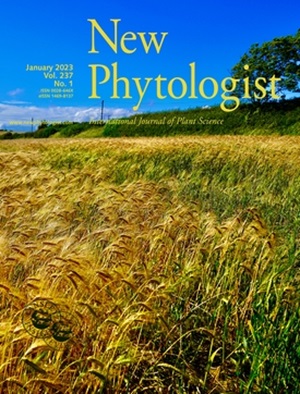绘制杨树叶片轮廓中由干旱引起的组织特征变化图。
IF 8.3
1区 生物学
Q1 PLANT SCIENCES
引用次数: 0
摘要
叶片结构会影响气体扩散的难易程度、生化过程和光合作用性能。对于北美广泛分布的树种--水杨来说,水分供应对叶片结构和随后的光合作用性能的影响仍然未知。为了弥补这一不足,我们利用 X 射线微计算机断层扫描技术,对土壤干燥和重新浇水后的树苗的叶片剖面进行了三维空间解剖学特征描述。我们的假设是,叶束片延伸(BSE)的丰度越高,相对于中叶体积(即中叶孔隙率θIAS)而言,干旱引起的细胞间空隙体积变化就越小,并通过支持叶片结构的完整性来帮助恢复。与'Gillam-5'相比,BSE 较少的'Carnduff-9'叶片表现出更大的θIAS、更高的海绵状中叶表面积、更小的栅栏状中叶表面积和更少的叶脉。在干旱条件下,"Carnduff-9 "叶片剖面的θIAS发生了显著变化,而 "Gillam-5 "的变化很小。在重新浇水的条件下,干旱引起的θIAS变化在'Gillam-5'中是完全可逆的,但在'Carnduff-9'中则不然。我们的数据表明,"健壮 "的叶片结构具有较高的 BSE 丰度、较低的 θIAS 和相对较大的叶肉表面积,可提高干旱条件下的光合作用能力,并支持杨树再灌水后叶片结构的恢复。本文章由计算机程序翻译,如有差异,请以英文原文为准。
Mapping of drought-induced changes in tissue characteristics across the leaf profile of Populus balsamifera
- Leaf architecture impacts gas diffusion, biochemical processes, and photosynthesis. For balsam poplar, a widespread North American species, the influence of water availability on leaf anatomy and subsequent photosynthetic performance remains unknown.
- To address this shortcoming, we characterized the anatomical changes across the leaf profile in three-dimensional space for saplings subjected to soil drying and rewatering using X-ray microcomputed tomography. Our hypothesis was that higher abundance of bundle sheath extensions (BSE) minimizes drought-induced changes in intercellular airspace volume relative to mesophyll volume (i.e. mesophyll porosity, θIAS) and aids recovery by supporting leaf structural integrity.
- Leaves of ‘Carnduff-9’ with less abundant BSEs exhibited greater θIAS, higher spongy mesophyll surface area, reduced palisade mesophyll surface area, and less veins compared with ‘Gillam-5’. Under drought conditions, Carnduff-9 showed significant changes in θIAS across leaf profile while that was little for ‘Gillam-5’. Under rewatered conditions, drought-induced changes in θIAS were fully reversible in ‘Gillam-5’ but not in ‘Carnduff-9’.
- Our data suggest that a ‘robust’ leaf structure with higher abundance of BSEs, reduced θIAS, and relatively large mesophyll surface area provides for improved photosynthetic capacity under drought and supports recovery in leaf architecture after rewatering in balsam poplar.
求助全文
通过发布文献求助,成功后即可免费获取论文全文。
去求助
来源期刊

New Phytologist
生物-植物科学
自引率
5.30%
发文量
728
期刊介绍:
New Phytologist is an international electronic journal published 24 times a year. It is owned by the New Phytologist Foundation, a non-profit-making charitable organization dedicated to promoting plant science. The journal publishes excellent, novel, rigorous, and timely research and scholarship in plant science and its applications. The articles cover topics in five sections: Physiology & Development, Environment, Interaction, Evolution, and Transformative Plant Biotechnology. These sections encompass intracellular processes, global environmental change, and encourage cross-disciplinary approaches. The journal recognizes the use of techniques from molecular and cell biology, functional genomics, modeling, and system-based approaches in plant science. Abstracting and Indexing Information for New Phytologist includes Academic Search, AgBiotech News & Information, Agroforestry Abstracts, Biochemistry & Biophysics Citation Index, Botanical Pesticides, CAB Abstracts®, Environment Index, Global Health, and Plant Breeding Abstracts, and others.
 求助内容:
求助内容: 应助结果提醒方式:
应助结果提醒方式:


